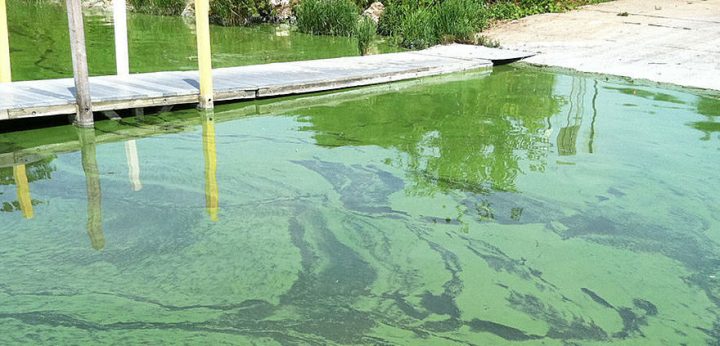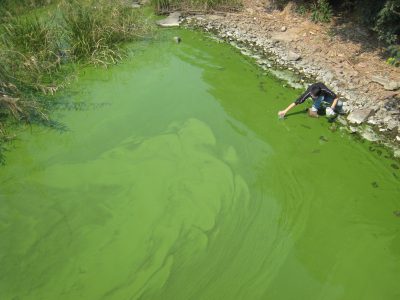
EDENTON — Blue-green algae is a simple organism in that its needs aren’t all that complex: A little heat, some water, sunshine, throw in some sort of nutrient and you have the ingredients of an algal bloom.
That was the case in late June in Edenton Bay, and last summer … and in 2015. Edenton is not the only place in eastern North Carolina that is prone to algal blooms, though. They regularly occur throughout the Neuse River estuary, and in the Pamlico River and Tar River. Blooms of this microscopic organism have become a regular summer feature of eastern North Carolina summers.
Supporter Spotlight
Smelly and potentially dangerous to humans and their pets, blue-green algae in sufficient quantity can rob the water of oxygen, potentially leading to massive fish kills.
Algae is not necessarily harmful, a point Mark Vander Borgh, algal ecologist with the North Carolina Department of Environmental Quality makes.

“Only a very small fraction can cause toxicity. Ninety-five percent are beneficial,” Vander Borgh said.
Blue-green algae, however, falls into the 5 percent not-beneficial group, but even that is not quite accurate — only certain blue-green algae are harmful.
The organism’s scientific name is cyanobacteria, and it is considered a bacterium, although it remains part of the algae family. In this case, it’s a single-celled alga.
Supporter Spotlight
There are several factors that make the cyanobacteria different. As bacteria go, this type is rather large. It is also the only bacteria group that is capable of photosynthesis, and it is the photosynthesis that gives it its blue-green hue. As the bloom dies off, there is frequently a blue tint in the water.
The algae are always present in the water and, given the right circumstances, can bloom at any time.
“All algae can bloom. It’s just a rapid growth of the algae,” Vander Borgh explained.
Although cyanobacteria require water, sunlight and a little heat to survive, their reproduction escalates rapidly when nutrients are added to the mix.
“The main reason for a bloom is nutrients,” said Hans Paerl, professor of marine and environmental sciences at the University of North Carolina Institute of Marine Sciences in Morehead City. “Nitrogen or phosphate are the most important causative factors.”

Nitrogen and phosphate are two of the most-used elements in fertilizers, and farm runoff is considered one of the most likely culprits in causing algal blooms.
Establishing where the nutrients originated, however, is a difficult task.
“There’s no single source that can be identified,” Vander Borgh said, adding that any storm event has the potential to trigger an algal bloom. “Stormwater runoff is the main source of pollutants in the country.”
Vander Borgh also noted that farm runoff is not the only potential source of nutrient. Animal waste, bird droppings and feces from other critters also contain nutrients.
“Poop is poop,” is his description.
Yet there is little doubt that the heavy use of fertilizers has contributed significantly to increased occurrences of algal blooms.
“The use of chemical fertilizers has increased dramatically since the end of World War II,” Paerl said.
Fertilizers are going to continue to be used, but effective mitigation steps have been developed.
One of the most successful methods of reducing fertilizer runoff is maintaining a riparian buffer between a cultivated field and the watershed. A riparian buffer, or a narrow zone of plants or grasses — usually native plants and grasses — bordering a stream, lake or pond is considered the primary line of defense in maintaining water quality. Riparian buffers not only stabilize stream banks and provide shade and habitat, but the vegetation filters stormwater runoff and absorbs nutrients.
“Riparian buffers have been a good thing for North Carolina,” Paerl said. “They are effective.”
Paerl noted that the state has improved its management of nutrient introduction into the state’s watersheds.
“I’ve been in North Carolina since 1978. I was working on the Chowan River. In 1978, we had massive blooms. I worked with the state on nutrient-management strategies,” he said. “Things have changed.”
Even with improved management practices, some areas are going to be more prone to algal blooms than others, and Edenton Bay falls into that category.
Located directly across from where the Roanoke River empties into the Albemarle Sound, at the western edge of the sound and the mouth of the Chowan River, the bay is perfectly positioned to catch the dominant southwest summer winds.
Surrounded by farmland, any nutrients that enter the water system upstream end up in Albemarle Sound.
“The (Albemarle) system has a very long memory for nutrients,” Paerl said.
Combine constant winds pushing nutrients and cyanobacteria into Edenton Bay, with no outlet for the water during southwest winds, mix in some summer heat and conditions are perfect for a blue-green algal bloom.
“Blue-green algae like a static environment, a good little flush of nutrients without disturbance to their little happy home,” Vander Borgh said.
Algal blooms are not inevitable, however, at any location. There are factors that go into determining how rapidly algae reproduction may occur and to what extent.
“In drought years, nutrients stay in place,” Paerl noted.

Other circumstances may contribute to nutrients entering the water system. Vander Borgh explained that land disturbance by developers also plays a role in downstream blooms.
How that land is developed is also important, as Paerl emphasized. Hoping to maximize the use of their land, developers often seek to build to the water’s edge, leaving no room for riparian buffers.
“There is some resistance from developers,” Paerl said.
Algal blooms have become less frequent since Paerl first arrived here in the 1970s, despite the recent uptick. There is no clear evidence if the recent increase is a trend or the result of better reporting or more public awareness.
Worldwide, however, it is a different story.
Paerl’s understanding extends far beyond the borders of North Carolina, including his extensive and ongoing work in China. From that global perspective, a trend has emerged.
“Things have gotten more extreme in the last 30 to 40 years,” Paerl said, adding that the ingredients are in place for a potentially significant increase in blooms during the next 20 to 30 years.
Florida in 2016 experienced massive algal blooms along the state’s Treasure Coast, Everglades and Lake Okeechobee, prompting the governor there to announce states of emergency. The American Civil Liberties Union said state officials did too little to warn the public of the associated health risks.
In China, repeated blue-green algal blooms on Lake Taihu have imperiled the drinking water supply for 12 million people.
“We have to get ahead of this before it gets to something like they have in Florida or China. We really don’t want what they have in China,” Paerl said.







